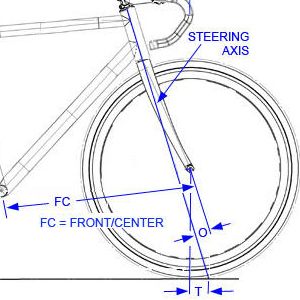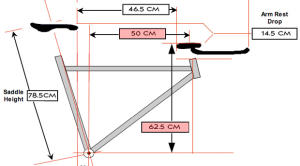
Many of these bike companies are coming up with charts or spreadsheets or calculators, and I wrote about some of them last week. You stick in the horizontal (X) and vertical (Y) dimensions to the armrest pads. Presto, the output is the exact complete bike solution.
This kind of calculator is very handy for these superbikes (tri bikes with integrated aerobars and stems). Look at the "related articles" just below the end of this article.
The conundrum you're left with is which size? In all of these articles linked to below on the P5 Six, IA, or Speed Concept I could have fit aboard 2, 3 or even 4 different sizes. How is that possible?
This is an involved discussion, so much so that I'm splitting it into 2 parts. In part-1 I'm only going to talk about this in the context of road race bikes, because the concepts are pretty easy. In part-2 I'll project the concept toward making the right tri bike purchase.
Let's use as an example the road bike I'm riding right now. It's a Cannondale Supersix EVO (like the one pictured above), in size 58cm, and it's got a -6° stem that is 120mm long, and a total of 10mm of stuff (headset dust cover, spacers) between the frame and the stem. (The bike pictured above has more than the 10mm of spacers on my Supersix EVO, but it does have the -6° stem pitch I have on my bike.)
Let us look at the stack and reach of this bike (we introduced the concepts of, and named, "stack" and "reach" here on Slowtwitch in 2003). Stack and reach are illustrated in the image below and to the right. Here are the stack and reach dimensions of the Supersix EVO in the sizes I might consider:
56cm: stack = 558mm; reach = 395mm
58cm: stack = 577mm; reach = 399mm
60cm: stack = 596mm; reach = 402mm
Let's assume I'm going to use the same handlebar on both sizes. Is the 58cm Supersix EVO the right size for me?

We love X and Y metrics in bike fitting in bike design. X and Y refer to the vertical and horizontal axis on a Cartesian graph, like this one directly below. You go up the Y axis so many units, you go out the X axis so many units. Remember this from high school?
Let me take as axiomatic you were bumming from coming off a high on the day they taught this (a not-unreasonable assumption), and you need me to go slow until it all comes back. Propellerheads, please indulge the rest of us.
We can do all kinds of things when we look at bike design this way. In the image further below we stuck a bike frame on top of that Cartesian graph, with the bottom bracket at (0,0). The top of the head tube is so many centimeters out the X axis and so many up the Y axis. That's stack and reach. We can use that same process to measure the horizontal and vertical distances the armrest pads sit above and in front of the bottom bracket. That's how these superbike fit systems work that I wrote about last week.
One metric we like to use in bike fitting, especially for road bikes, is yet another X/Y dimension from the bottom bracket, this time to the handlebar clamp (where the bar passes through the stem).
In fact, this is how we perform bike fits. We (the fitters) stick you on a fit bike (GURU, Purely Custom, etc.), we position you, and once we have you in a nice, comfortable, aerodynamic position the fit bike spits out this X and Y dimension to the handlebar clamp.
If I was to be fit aboard one of these fit bikes, with my positioned dialed in, that place where my handlebar passes through the stem is 625mm above the bottom bracket (the Y axis), and 505mm in front of it (the X axis). We call these two numbers "Handlebar X/Y."
The propelleheads just perked up. Yes, I know, this is very close to my Pad X/Y on my tri bike. Is this a coincidence or is there something to this? I'm still wondering how many people fit this coincidence, but that's an investigation for another time.

Let's plunk my Handlebar X and Y into a calculator. If you go to that calculator you'll see that it asks a number of questions. It wants to know stem length and stem pitch (is the stem angled up, or down, or parallel to the ground). Why?
This calculator is figuring out what the X and Y dimensions are of just the front end of the bike (stem, spacers, and so forth). If we know the X and Y from the bottom bracket to the handlebar clamp, and we subtract the X and Y of everything between the frame and the handlebar clamp, what we're left with is the X and Y from the bottom bracket to the top of the head tube, which is stack and reach. We then go to the stack and reach tables and see what frames match.
What numbers do I stick into this calculator? How do I know what length and pitch stem to choose? And how many spacers?
There is some wiggle room here. If I'm the fitter I just imagine what I think is an elegant way to build your bike up. The stem should be too long or short, it shouldn't be too high or low.
I'm plunking into that calculator a -6° stem, 120mm long, with 10mm total of headset dust cover + spacers. (I'll tell you below why I'm choosing this front end.) When I plunk these numbers in and press "calculate" the resulting frame I am looking for has a stack and reach of 578mm and 396mm respectively. (Try it. Plunk all those numbers into that calculator, take that calculator out for a spin yourself.)
Again, here is the stack and reach of the Cannondale Supersix EVO in three successive sizes:
56cm: stack = 558mm; reach = 395mm
58cm: stack = 577mm; reach = 399mm
60cm: stack = 596mm; reach = 402mm
Can you see why I chose that bike in is 58cm size? When I choose that particular front end, the resulting stack and reach for the frame that fits in there is almost exactly the same as the stack and reach of the 58cm Supersix EVO. Some might object that I'm letting the front end config drive the decision of the frame. Yes. Guilty. (More on this below.)
You'll note that the 56cm version of that bike has a very similar length. (See how the reach numbers of these two sizes are very close.) The difference between these sizes is that the 56cm size is mostly lower in front, by about 20mm. I am, or would be, able to ride this bike in 56cm. Here's how I know:
Let's take my same handlebar X/Y of 625mm and 505mm, go to that calculator linked to above, and plunk in a different front end. Let's stick in there a stem 130mm long, keep that same -6° angle, and put 30mm of total spacers under the stem instead of 10mm. That calculator will output – prescribe – a bike with a stack and reach of 557mm and 392mm. Not very far off from that 56cm EVO Supersix, is it?
And for good measure, if I plunk into that calculator a 110mm stem, angled at -17° (parallel to the ground) instead of -6°, with 10mm of total top cap + spacers here's the frame geometry that the calculator outputs: Stack = 596mm; Reach = 404mm.
A Supersix EVO in size 60cm has: Stack = 596mm; Reach = 402mm. So, I can ride the 60cm Supersix as well.

Realize what is happening here. The larger-sized frame is longer and taller, so I must compensate with a front end (stem length and pitch, along with spacers) that is shorter and offers less height. A smaller-sized frame's head tube top terminates lower, and not as far in front of the BB. I must make up that length with a stem that is longer, and find the extra height I need by pitching that stem up in angle, and maybe slotting in some headset spacers.
This is exactly what happens when you look at these charts and spreadsheets and calculators for superbikes. When these calculators say you can ride a Medium or Large, or a 54cm or a 56cm, and maybe even a 58cm, a compensation is made in the front end of the bike (the handlebar/stem system). It's not that these calculators aren't precise. They're very precise. They are solving a fit problem.
What they are not doing is solving a handling problem.
Let's work through the handling problem now.
I am a guy with few and basic needs. On my road race bike, beyond the mechanical aspects (shifting, braking), and contact point comfort, and assuming my fit coordinates are achieved, my primary concerns are:
1. Is the bike stable at all speeds in all positions, including a tuck?
2. Is the bike's handling pleasing when I'm out of the saddle?
3. Does the bike corner and descend well?
There you go. There it is. Using these imperatives, what about the Supersix EVO in its 56cm size? No, I don't want that, because there's more height in that front-end config than I'd like. Remember, my handlebar Y is 625mm. The 56cm bike's stack is 558mm. That stem/spacer combo yields roughly 70mm of raw height between the head tube top and the handlebar clamp center. Is that too much to even consider? No. In fact, there are a lot of bikes out there that have a config just like this. But it's more height than is ideal. Why?

Remember my imperatives. Stability. Predictability. No surprises, like speed wobble while tucking at 45mph. I believe speed wobble is almost entirely due to a lack of system stiffness or, it not, it's almost entirely solved when system stiffness is increased. While I have not tested it, I assume that the larger frame size offers more inherent stiffness than the corresponding height offered by the fork steer column. Adding 20mm of extra steerer and 10mm of extra stem length is not my preference. I'd rather not bolt my stem to the top of a pole vault pole.
What about the 60cm bike, using my own reasoning above? At some point the steering lever (the distance from the steering axis to the point where the turn is executed (where your hand grips the bar on a road bike) is short enough to make the bike feel choppy when turning (and by turning I don't mean cornering, but just the turning from side to side when riding out of the saddle).
So the 58cm size is it. I can ride the Supersix EVO in size 56cm and 60cm, but neither offers the front end that I like.
The other element to this I have not discussed is weight distribution. If you choose the smaller size you might not have enough weight on the rear of the bike, especially when climbing out of the saddle. The chain stay, or rear/center, distances on all these bikes are very often the same throughout the size run. It's the front/center (look at the image directly above) that changes throughout the size run.
This becomes a bigger problem in tri than in road, because so much weight on a tri bike is already on the front wheel (much more than on a road race bike). Thus, front/center becomes a key influencer when determining which size to buy when 2 or 3 sizes of the same model tri bike will fit you. A tri bike too long is also a problem in tri, and we'll discuss this in part-2.


